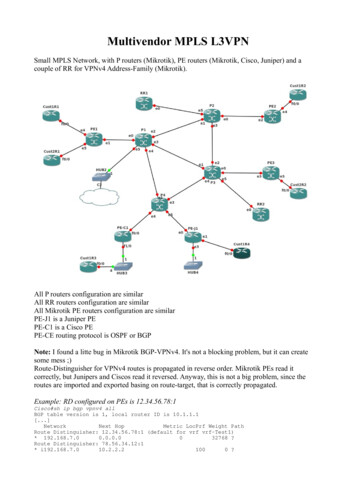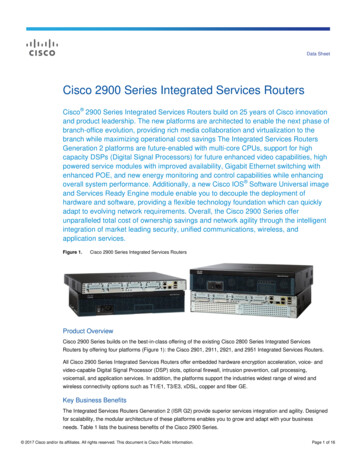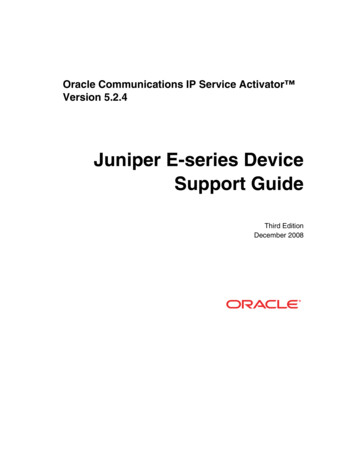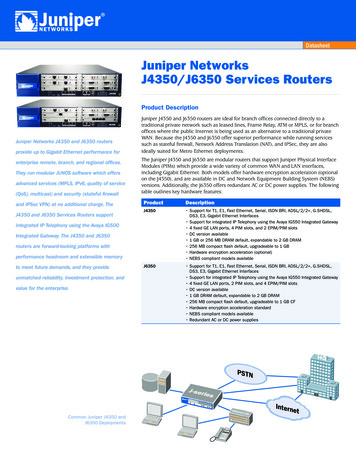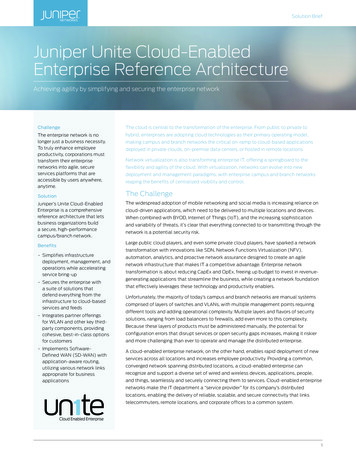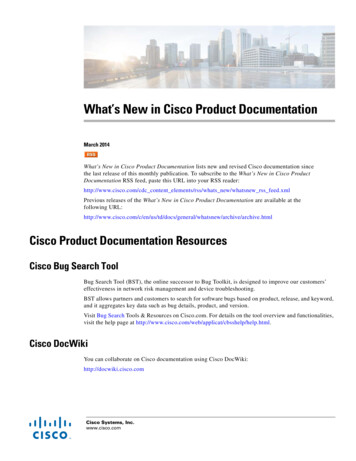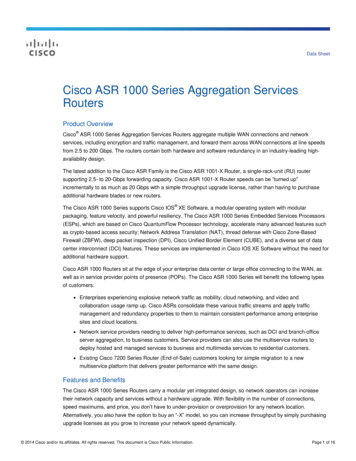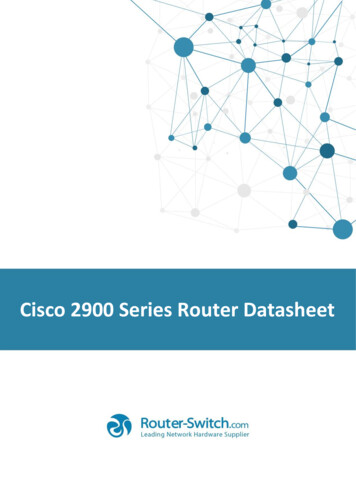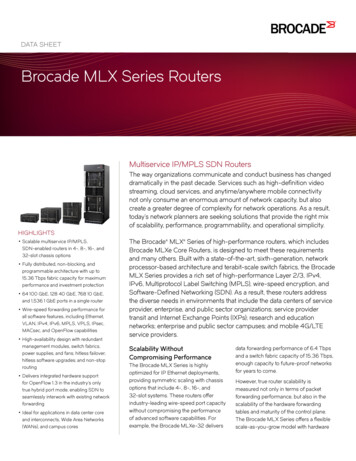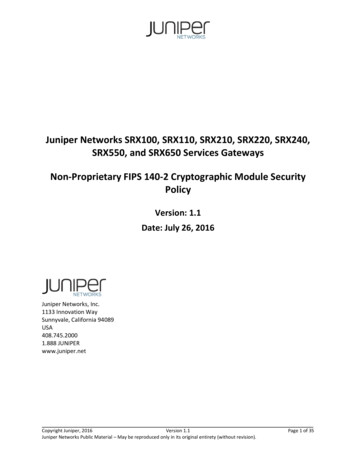
Transcription
Juniper J-Series Services Routers:J2320, J2350, J4350, J6350Security PolicyDocument Version: 1.1Date: August 31, 2010Juniper Networks, Inc.1194 North Mathilda AvenueSunnyvale, California 94089USA408.745.20001.888 JUNIPERwww.juniper.net
Table of ContentsTable of Contents . 2List of Tables . 21. Module Overview . 32. Security Level . 53. Modes of Operation . 5Approved Mode of Operation . 5Non-FIPS Mode of Operation . 64. Ports and Interfaces . 65. Identification and Authentication Policy . 6Assumption of Roles . 66. Access Control Policy . 9Roles and Services . 9Unauthenticated Services . 9Definition of Critical Security Parameters (CSPs) . 9Definition of Public Keys . 11Definition of CSP Modes of Access . 127. Operational Environment . 128. Security Rules . 129. Physical Security Policy . 14Physical Security Mechanisms . 14Tamper Seal Placement . 1410. Mitigation of Other Attacks Policy . 1711. Acronyms . 18About Juniper Networks . 19List of TablesTable 1.Table 2.Table 3.Table 4.Table 5.Table 6.Table 7.Table 8.Table 9.Table 10.J-Series Configurations . 3Security Level . 5Roles and Required Identification and Authentication . 7Strengths of Authentication Mechanisms . 8Services Authorized for Roles . 9Table of CSPs . 9Table of Public Keys . 11CSP Access Rights within Roles & Services . 12Inspection/Testing of Physical Security Mechanisms . 14Mitigation of Other Attacks . 17Juniper Networks J‐Series Services Routers Security PolicyPage 2
1. Module OverviewThe Juniper J-Series Services Routers: J2320, J2350, J4350, J6350 are multiple-chip standalone cryptographic modules that executeJUNOS-FIPS firmware on the Juniper Networks J-Series routers. The validated version of JUNOS-FIPS is 9.3R3; the image isjunos-juniper-9.3R3-fips.tgz. See Table 1 below for hardware specifics. JUNOS-FIPS is a release of the JUNOS operatingsystem, the first routing operating system designed specifically for the Internet. JUNOS Software is currently deployed in the largestand fastest-growing networks worldwide. A full suite of industrial-strength routing protocols, a flexible policy language, and a leadingMPLS implementation efficiently scale to large numbers of network interfaces and routes.The J-Series Services Routers: J2320, J2350, J4350, J6350 meet the requirements of the FIPS Publication 140-2. Each cryptographicmodule’s operational environment is a limited operational environment. The cryptographic boundary is defined as being the outeredge of each module’s chassis. Figure 1 below shows the modules.Table 1.J-Series ConfigurationsSeriesModelHW Part 350-JBJ6350J-6350-JBJuniper Networks J‐Series Services Routers Security PolicyPage 3
Figure 1.Images of the Cryptographic ModulesJ2320J2350J4350J6350Juniper Networks J‐Series Services Routers Security PolicyPage 4
2. Security LevelThe cryptographic modules, which each have a multiple-chip standalone embodiment, meet the overall requirements applicable toLevel 2 security of FIPS 140-2.Table 2.Security LevelSecurity Requirements SectionLevelCryptographic Module Specification2Module Ports and Interfaces2Roles, Services and Authentication2Finite State Model2Physical Security2Operational EnvironmentN/ACryptographic Key Management2EMI/EMC3Self-Tests2Design Assurance3Mitigation of Other AttacksN/A3. Modes of OperationApproved Mode of OperationThe cryptographic modules support FIPS-Approved algorithms as follows: AES 128, 192, 256 for encryption/decryption ECDSA with Curve P-192 for digital signature generation and verification DSA with 1024-bit keys for digital signature generation and verification RSA with 1024 or 2048-bit keys for digital signature generation and verification Triple-DES for encryption/decryption SHA-1 for hashing SHA-2 for hashing (SHA-224, SHA-256, SHA-384, SHA-512) HMAC-SHA-1 HMAC-SHA-256 AES-128-CMAC FIPS 186-2 RNG (with Change Notice)The cryptographic modules also support the following non-Approved algorithms which are allowed for use in FIPS mode: RSA with 1024-bit keys (key wrapping; key establishment methodology provides 80 bits of encryption strength) MD5 and HMAC-MD5Juniper Networks J‐Series Services Routers Security PolicyPage 5
Diffie-Hellman with 1024-bit keys (key agreement; key establishment methodology provides 80 bits of encryptionstrength) Non-Approved RNG (used to seed Approved FIPS 186-2 RNG)The cryptographic modules support the commercially available TLS, IKEv1, and SSH protocols for key establishment in accordancewith FIPS 140-2 Annex D.The cryptographic modules rely on the implemented deterministic random number generator (RNG) that is compliant with FIPS 186-2for generation of all cryptographic keys in accordance with FIPS 140-2 Annex C.Non-FIPS Mode of OperationThe cryptographic modules do not provide a non-Approved mode of operation.4. Ports and InterfacesThe cryptographic modules support the following physical ports and corresponding logical interfaces: Ethernet: Data Input, Data Output, Control Input, Status Outputs Serial: Data Input, Data Output, Control Input, Status Outputs Power interface: Power Input Reset: Control Input LEDs: Status Output5. Identification and Authentication PolicyAssumption of RolesThe cryptographic modules support two distinct operator roles as follows: FIPS User Cryptographic Officer (CO)The cryptographic modules shall enforce the separation of roles using either identity-based or role-based operator authentication; thecryptographic modules meet Level 2 requirements because identity-based authentication is not enforced for all authorized services.Juniper Networks J‐Series Services Routers Security PolicyPage 6
Table 3.Roles and Required Identification and AuthenticationRoleType of AuthenticationFIPS UserIdentity-based operator authenticationAuthentication Data Via Console: Username and password Via SSH-2: Password or RSA signature verification orDSA signature verificationCryptographic OfficerRole-based authentication Via RADIUS or TACACS : Pre-shared secret,minimum 10 charactersIdentity-based operator authentication Via Console: Username and password Via SSH-2: Password or RSA signature verification orDSA signature verificationRole-based authenticationJuniper Networks J‐Series Services Routers Security Policy Via RADIUS or TACACS : Pre-shared secret,minimum 10 charactersPage 7
Table 4.Strengths of Authentication MechanismsAuthentication MechanismStrength of MechanismUsername and passwordThe module enforces 10-character passwords (at minimum) chosen from the 96 human readable ASCII characters.The module enforces a timed access mechanism as follows: For the first two failedattempts (assuming 0 time to process), no timed access is enforced. Upon the thirdattempt, the module enforces a 5-second delay. Each failed attempt thereafter resultsin an additional 5-second delay above the previous (e.g. 4th failed attempt 10-seconddelay, 5th failed attempt 15-second delay, 6th failed attempt 20-second delay, 7thfailed attempt 25-second delay).This leads to a maximum of 7 possible attempts in a one-minute period for each getty.The best approach for the attacker would be to disconnect after 4 failed attempts, andwait for a new getty to be spawned. This would allow the attacker to perform roughly9.6 attempts per minute (576 attempts per hour/60 mins); this would be rounded downto 9 per minute, because there is no such thing as 0.6 attempts. Thus the probability ofa successful random attempt is 1/9610, which is less than 1/1 million. The probability ofa success with multiple consecutive attempts in a one-minute period is 9/(9610), whichis less than 1/100,000.RSA signatureThe module supports RSA (1024 or 2048-bit), which has a minimum equivalentcomputational resistance to attack of either 280 or 2112 depending on the modulus size.Thus the probability of a successful random attempt is 1/(280) or 1/ (2112), which areboth less than 1/1,000,000. The probability of a success with multiple consecutiveattempts in a one-minute period is 5.6e7/(280) or 5.6e7/(2112), which are both less than1/100,000.DSA signatureThe module supports DSA (1024-bit only) which have an equivalent computationalresistance to attack of 280. Thus the probability of a successful random attempt is1/ 280, which is less than 1/1,000,000. The probability of a success with multipleconsecutive attempts in a one-minute period is 5.6e7/(280), which is less than1/100,000.Juniper Networks J‐Series Services Routers Security PolicyPage 8
6. Access Control PolicyRoles and ServicesTable 5.Services Authorized for RolesRoleAuthorized ServicesUser: Configuration Management: Allows the user to configure the router.Configures and monitors the routervia the console or SSH-2 Router Control: Allows the user to modify the state of the router. (Example: shutdown,reboot) Status Checks: Allows the user to get the current status of the router. JUNOScript: Provides script handling service for module via SSH-2 or TLS session. SSH-2: Provides encrypted login via the SSH-2 protocol. Console Access: Provides direct login access via the console.Cryptographic Officer: Configuration Management: Allows the CO to configure the router.Configures and monitors the REvia the console or SSH-2. Also haspermissions to view and editsecrets within the module. Router Control: Allows the user to modify the state of the router. (Example: shutdown,reboot) Status Checks: Allows the user to get the current status of the router. Zeroize: Allows the user to zeroize the configuration (all CSPs) within the module. Load New Software: Allows the verification and loading of new software into the router.Note: Loading of software invalidates the module’s FIPS 140-2 validation. JUNOScript: Provides script handling service for module via SSH-2 or TLS session. SSH-2: Provides encrypted login via the SSH-2 protocol. Console Access: Provides direct login access via the console.Unauthenticated ServicesThe cryptographic modules support the following unauthenticated services: Show Status: Provides the current status of the cryptographic module Self-tests: Executes the suite of self-tests required by FIPS 140-2 Routing Protocols: Unauthenticated routing protocols (e.g., TCP, UDP) SNMP Traps (Status)Definition of Critical Security Parameters (CSPs)Table 6.Table of CSPsCSPDescriptionSSH-2 Private Host KeyThe first time SSH-2 is configured, the key is generated. RSA, DSA.Used to Identify the host. 1024-bit or 2048-bit length.SSH-2 Session KeySession keys used with SSH, TDES (3 key), AES 128, 192, 256,HMAC-SHA-1 key (160), DH Private Key 1024TLS Host Certificate, Private PortionX.509 certificates for TLS for authentication. RSA or DSATLS Session ParametersSession keys used with TLS, TDES (2 or 3 key), AES 128, 192, 256,Juniper Networks J‐Series Services Routers Security PolicyPage 9
CSPDescriptionHMAC-SHA-1; Pre-master SecretUser Authentication KeyHMAC-SHA-1 KeyUsed to authenticate users to the module.CO Authentication KeyHMAC-SHA-1 KeyUsed to authenticate COs to the module.IPsec SAsSession keys used within IPsec.TDES (3 key), HMAC-SHA-1IKE Session ParametersNonces, DH Private Key 1024-bit keys, TDES, HMAC-SHA-1, usedwithin IKERADIUS shared secretUsed to authenticate COs and Users (10 chars minimum)This includes the Authentication Data BlockTACACS shared secretUsed to authenticate COs and Users (10 chars minimum)This includes the Authentication Data BlockApproved RNG StateJuniper Networks J‐Series Services Routers Security PolicyRNG seed and seed keyPage 10
Definition of Public KeysTable 7.Table of Public KeysKeyDescription/UsageSSH-2 Public Host KeyFirst time SSH-2 is configured, the key is generated. RSA (1024 or 2048-bit),DSA. Identify the host.TLS Host Certificate, Public PortionX.509 certificates for TLS for authentication. RSA (1024 or 2048-bit) or DSAUser Authentication Public KeysUsed to authenticate users to the module. RSA (1024 or 2048-bit) or DSACO Authentication Public KeysUsed to authenticate CO to the module. RSA (1024 or 2048-bit) or DSAJuniperRootCARSA 2048-bit X.509 certificateUsed to verify the validity of the Juniper image at software load and also atruntime for integrity.EngineeringCARSA 2048-bit X.509 certificateUsed to verify the validity of the Juniper image at software load and also atruntime for integrity.PackageCARSA 2048-bit X.509 certificateUsed to verify the validity of the Juniper image at software load and also atruntime for integrity.PackageProductionRSA 2048-bit X.509 certificateCertificate that holds the public key of the signing key that was used togenerate all the signatures used on the packages and signature lists.DH Public KeysUsed within IKE and SSH-2 for key establishment.Juniper Networks J‐Series Services Routers Security PolicyPage 11
Definition of CSP Modes of AccessTable 8 defines the relationship between access to CSPs and the different module services. The modes of access shown in the table aredefined as follows:Table 8.CSP Access Rights within Roles & ServicesRoleServiceCryptographic Keys and CSP Access OperationR Read, W Write, D DeleteCOUserXConfigurationManagementAll CSPs (R, W, D)XConfigurationManagementNo access to CSPsXXRouter ControlNo access to CSPsXXStatus ChecksNo access to CSPsXZeroizeAll CSPs (D)XLoad New SoftwareNo access to CSPsXJUNOScriptAll CSPs (R, W, D)XJUNOScriptNo access to CSPsXXSSH-2SSH-2 session key (R)XXConsole AccessCO Authentication Key, User Authentication Key (R)7. Operational EnvironmentThe FIPS 140-2 Area 6 Operational Environment requirements are not applicable because each cryptographic module has a limitedoperational environment.8. Security RulesEach cryptographic module’s design corresponds to the cryptographic module’s security rules. This section documents the securityrules enforced by the cryptographic modules to implement the security requirements of a FIPS 140-2 Level 2 module.1.2.3.4.The cryptographic modules shall provide two distinct operator roles. These are the FIPS User role and the Cryptographic Officerrole,.The cryptographic modules shall support both role-based and identity-based authentication mechanisms.Authentication of identity to an authorized role is required for all services that modify, disclose, or substitute CSPs, use Approvedsecurity functions, or otherwise affect the security of the cryptographic modules.The cryptographic modules shall perform the following tests: Power up testsA. Cryptographic algorithm testsi.TDES KATJuniper Networks J‐Series Services Routers Security PolicyPage 12
ii.iii.iv.v.vi.vii.viii.ix.x.xi.xii.xiii.AES KATAES CMAC KATSHA-1 KATSHA-224, 256, 384, 512 KATHMAC-SHA-1 KATHMAC-SHA-256 KATECDH KATECDSA pairwise consistency test (sign/verify) and KATRSA pairwise consistency test (sign/verify and encrypt/decrypt) and KATDSA pairwise consistency test (sign/verify) and KATFIPS 186-2 RNG KATKDF KATsB. Firmware integrity test:i.RSA digital signature verification (PKCS1.5, 2048-bit key, SHA-1) and SHA-1 hashverificationC. Critical functions testsi.Verification of Limited Environmentii.Verification of Integrity of Optional Packages Conditional testsD. Pairwise consistency testsi.ECDSA pairwise consistency testii.RSA pairwise consistency test (sign/verify and encrypt/decrypt)iii.DSA pairwise consistency test (sign/verify)E. Firmware load test: RSA digital signature verification (2048-bit key)F. Manual key entry test: Duplicate key entries testG. Continuous random number generator test: performed on the Approved FIPS 186-2, Appendix 3.1 RNG,and on a non-Approved RNG that is used to seed the Approved RNG.H. Bypass test is not applicable.5.6.7.8.9.Any time the cryptographic modules are in an idle state, the operator shall be capable of commanding the modules to perform thepower-up self-test by power-cycling the module.Prior to each use, the internal RNG shall be tested using the continuous random number generation conditional test.Data output shall be inhibited during key generation, self-tests, zeroization, and error states.Status information shall not contain CSPs or sensitive data that if misused could lead to a compromise of the modules.The modules shall support concurrent operators.Juniper Networks J‐Series Services Routers Security PolicyPage 13
9. Physical Security PolicyPhysical Security MechanismsEach module’s physical embodiment is that of a multi-chip standalone device that meets Level 2 Physical Security requirements. Themodules are completely enclosed in a nickel or clear zinc coated cold rolled steel and plated steel and brushed aluminum. There are noventilation holes, gaps, slits, cracks, slots, or crevices that would allow observation of any kind to any component contained within thephysically contiguous cryptographic boundary. Tamper evident seals are used to provide evidence in case the modules are physicallytampered with. Tamper evident seals must be applied to operate as FIPS 140-2 Approved modules.Table 9.Inspection/Testing of Physical Security MechanismsPhysical Security MechanismsRecommended Frequency ofInspection/TestInspection/Test Guidance DetailsTamper labels, opaque metal enclosure.The Crypto-Officer must inspect all tamperlabel locations for the assembled chassiscomponents to verify proper configurationthroughout the lifespan of the module; it isrecommended this is done on regularintervals.Labels should be free of any tamperevidence.Tamper Seal PlacementSeal Application InstructionsFor all seal applications, observe the following instructions. Handle the seals with care. Do not touch the adhesive side. All surfaces to which the seals will be applied must be clean and dry. Ensure all surfaces are clean and clear of any residue. Apply with firm pressure across the seal to ensure adhesion. Allow at least 1 hour for the adhesive to cure.J2320 (7 seals), J2350 (9 seals)Tamper evident seals shall be applied to the following locations highlighted in red (Figures 2, 3 and 4): The front of the chassis, across the ends of each of the PIM blanking/filler plates, extending onto the chassis of the module(Figures 2 and 3) The front of the chassis, horizontally, covering the two USB ports (Figure 2 and 3) The rear of the modules, over the center of the cover plate, extending to the bottom of the chassis (Figure 4) The rear of the J2350, across the edge of the ventilation screen, extending around to the side of the chassis (Figure 4)PIM blanking/filler platesUSB portsFigure 2. J2320 Tamper Evident Seal Location for Front (6 total)Juniper Networks J‐Series Services Routers Security PolicyPage 14
PIM blanking/filler plateUSB portsFigure 3. J2350 Tamper Evident Seal Location for Front (7 total)For J2320 andJ2350Rear CoverPlateFor J2350 only –Ventilation ScreenFigure 4. J2320 and J2350 Tamper Evident Seal Location for Rear (J2320 - 1 total, J2350 - 2 total)J4350 (13 seals), J6350 (13 seals)Tamper evident seals shall be applied to the following locations highlighted in red (Figures 5, 6, 7 and 8): The front of the modules, vertically, across each of the installed interface cards, or slot covers, extending onto the chassis ofthe modules (Figure 5) The front of the modules, horizontally, across both sides of the removable ventilation cover (Figure 5) The front of the modules, vertically, across the USB ports (Figure 5) (For the J4350 only) Covering the power supply covers at the back of the module and extending onto the removable cover(Figure 6) (For the J4350 only) Covering the screw to the left of the power supply fan (Figure 6) (For the J6350 only) Covering the power supply cover at the rear of the module and extending onto the module’s removablecover (Figure 7) (For the J6350 only) Covering the power supply and extending onto the underside of the chassis (Figure 7) The top of the module’s removable cover and extending onto the side of the chassis opposite the power supply (Figure 8)PIM blanking/filler platesVentilation CoverUSB portsFigure 5. J4350 and J6350 Tamper Evident Seal Location for the Front (10 total)Juniper Networks J‐Series Services Routers Security PolicyPage 15
ScrewFigure 6. J4350 Tamper Evident Seal Location for Rear (2 total)Figure 7. J6350 Tamper Evident Seal Location for Rear (2 total)Figure 8. J4350 and J6350 Tamper Evident Seal Location for Rear Corner- Opposite Power Supply (1 total)Juniper Networks J‐Series Services Routers Security PolicyPage 16
10. Mitigation of Other Attacks PolicyThe modules have not been designed to mitigate attacks that are outside the scope of FIPS 140-2.Table 10.Mitigation of Other AttacksOther AttacksMitigation MechanismSpecific LimitationsN/AN/AN/AJuniper Networks J‐Series Services Routers Security PolicyPage 17
11. AcronymsACRONYMDESCRIPTIONAESAdvanced Encryption StandardDESData Encryption StandardDSADigital Signature AlgorithmEMCElectromagnetic CompatibilityEMIElectromagnetic InterferenceFIPSFederal Information Processing StandardGMPLSGeneral Multiprotocol Label SwitchingHMAC-SHA-1Keyed-Hash Message Authentication CodeIKEInternet Key Exchange ProtocolIPsecInternet Protocol SecurityMD5Message Digest 5MPLSMultiprotocol Label SwitchingPICPhysical Interface CardRADIUSRemote Authentication Dial-In User ServiceRERouting EngineRSAPublic-key encryption technology developed by RSA Data Security, Inc. The acronym stands for Rivest,Shamir, and Adelman.SASecurity AssociationSHA-1Secure Hash AlgorithmsSSHSecure ShellSSLSecure Sockets LayerTACACSTerminal Access Controller Access Control SystemTCPTransmission Control ProtocolTDESTriple - Data Encryption StandardTLSTransport Layer SecurityUDPUser Datagram ProtocolJuniper Networks J‐Series Services Routers Security PolicyPage 18
About Juniper NetworksJuniper Networks, Inc. is the leader in high-performance networking. Juniper offers a high-performance network infrastructure thatcreates a responsive and trusted environment for accelerating the deployment of services and applications over a single network. Thisfuels high-performance businesses. Additional information can be found at www.juniper.net.Copyright 2009 Juniper Networks, Inc. May be reproduced only in its original entirety [without revision]Juniper Networks, the Juniper Networks logo, JUNOS, NetScreen, and ScreenOS are registered trademarks of Juniper Networks, Inc.in the United States and other countries. All other trademarks, service marks, registered trademarks, or registered service marks are theproperty of their respective owners. Juniper Networks assumes no responsibility for any inaccuracies in this document. JuniperNetworks reserves the right to change, modify, transfer, or otherwise revise this publication without notice.Juniper Networks J‐Series Services Routers Security PolicyPage 19
The validated version of JUNOS-FIPS is 9.3R3; the image is junos-juniper-9.3R3-fips.tgz. See Table 1 below for hardware specifics. JUNOS-FIPS is a release of the JUNOS operating system, the first routing operating system designed specifically for the Internet. JUNOS Software is currently deployed in the largest and fastest-growing networks .
